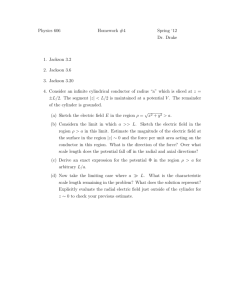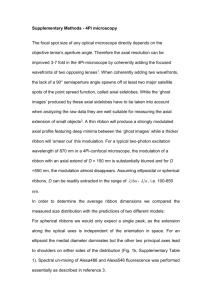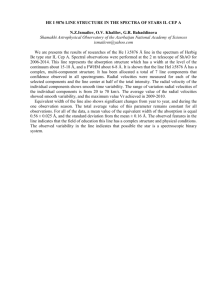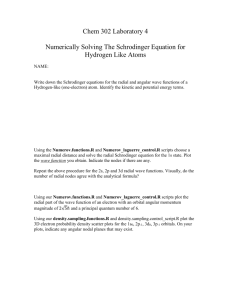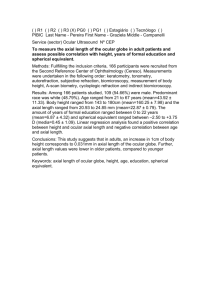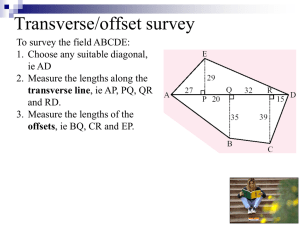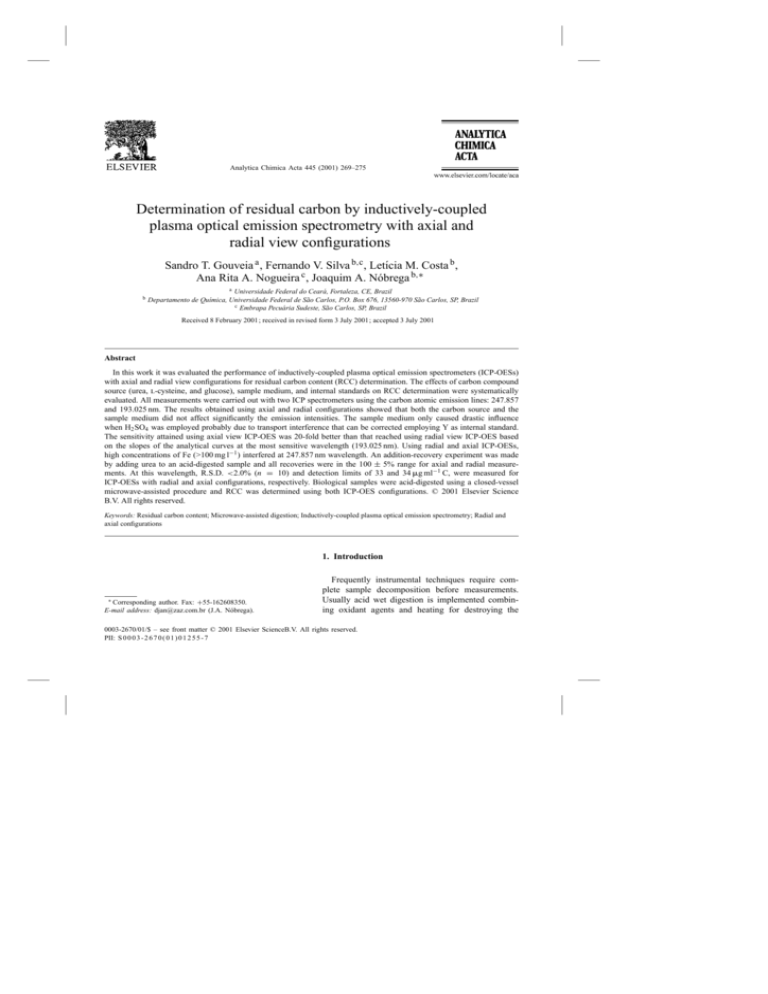
Analytica Chimica Acta 445 (2001) 269–275
Determination of residual carbon by inductively-coupled
plasma optical emission spectrometry with axial and
radial view configurations
Sandro T. Gouveia a , Fernando V. Silva b,c , Letı́cia M. Costa b ,
Ana Rita A. Nogueira c , Joaquim A. Nóbrega b,∗
b
a Universidade Federal do Ceará, Fortaleza, CE, Brazil
Departamento de Quı́mica, Universidade Federal de São Carlos, P.O. Box 676, 13560-970 São Carlos, SP, Brazil
c Embrapa Pecuária Sudeste, São Carlos, SP, Brazil
Received 8 February 2001; received in revised form 3 July 2001; accepted 3 July 2001
Abstract
In this work it was evaluated the performance of inductively-coupled plasma optical emission spectrometers (ICP-OESs)
with axial and radial view configurations for residual carbon content (RCC) determination. The effects of carbon compound
source (urea, l-cysteine, and glucose), sample medium, and internal standards on RCC determination were systematically
evaluated. All measurements were carried out with two ICP spectrometers using the carbon atomic emission lines: 247.857
and 193.025 nm. The results obtained using axial and radial configurations showed that both the carbon source and the
sample medium did not affect significantly the emission intensities. The sample medium only caused drastic influence
when H2 SO4 was employed probably due to transport interference that can be corrected employing Y as internal standard.
The sensitivity attained using axial view ICP-OES was 20-fold better than that reached using radial view ICP-OES based
on the slopes of the analytical curves at the most sensitive wavelength (193.025 nm). Using radial and axial ICP-OESs,
high concentrations of Fe (>100 mg l−1 ) interfered at 247.857 nm wavelength. An addition-recovery experiment was made
by adding urea to an acid-digested sample and all recoveries were in the 100 ± 5% range for axial and radial measurements. At this wavelength, R.S.D. <2.0% (n = 10) and detection limits of 33 and 34 g ml−1 C, were measured for
ICP-OESs with radial and axial configurations, respectively. Biological samples were acid-digested using a closed-vessel
microwave-assisted procedure and RCC was determined using both ICP-OES configurations. © 2001 Elsevier Science
B.V. All rights reserved.
Keywords: Residual carbon content; Microwave-assisted digestion; Inductively-coupled plasma optical emission spectrometry; Radial and
axial configurations
1. Introduction
∗ Corresponding author. Fax: +55-162608350.
E-mail address: djan@zaz.com.br (J.A. Nóbrega).
Frequently instrumental techniques require complete sample decomposition before measurements.
Usually acid wet digestion is implemented combining oxidant agents and heating for destroying the
0003-2670/01/$ – see front matter © 2001 Elsevier ScienceB.V. All rights reserved.
PII: S 0 0 0 3 - 2 6 7 0 ( 0 1 ) 0 1 2 5 5 - 7
270
S.T. Gouveia et al. / Analytica Chimica Acta 445 (2001) 269–275
organic fraction of the sample [1]. However, due to
the high stability of some organic compounds present
in samples or formed during decomposition, incomplete oxidation is generally observed. Spectroanalytical techniques may not be critically affected by the
residual carbon content (RCC) [2,3]. On the other
hand, the application of electroanalytical techniques
can be severely limited [4–6]. Therefore, RCC is an
important parameter to be controlled depending on
the instrumental technique used. Additionally, RCC
measurement is an important parameter to evaluate
the efficacy of sample decomposition procedures.
Different approaches were proposed for RCC determination [6–8]. Elemental analysis or spectrophotometric titration of the organic matter with chromic
acid can be used for this purpose [6]. In this latter
procedure, controlled reaction conditions and experienced analysts are required to reach suitable accuracy.
Inductively-coupled plasma optical emission spectrometry (ICP-OES) was also applied for RCC determination [7,8]. The RCC presents in natural waters
was determined by Emteryd et al. [7] using a flow
injection system coupled to an ICP-OES spectrometer [7]. The measurements were made at 193.091 nm
wavelength and solutions prepared from citric acid
or potassium hydrogen phthalate were used for calibration. The obtained results were in agreement with
those determined by elemental analysis. Krushevska
et al. [8] also used the C emission line 193.091 nm to
perform RCC determination in milk sample digests.
Recoveries of aliphatic and aromatic compounds were
evaluated in different sample media. Recovery values around 100% were achieved using Sc as internal
standard. The authors also mentioned memory effects
in the spray-chamber when measuring aromatic compounds. Long washout times were required to reduce
this effect.
Considering the emerging of solid state detectors
and changes of the optical system in ICP-OESs, the
present work investigated the determination of RCC in
acid-digested biological samples using ICP-OESs with
axial and radial view configurations. The main experimental parameters and figures of merit were systematically evaluated and further correlated with the employed configuration. The axial and radial ICP-OESs
developed procedures were compared to TOC analyzer in order to assess the accuracy of obtained
results. The developed procedures were also applied to
assess the digestion efficiency of microwave-assisted
digestion procedures.
2. Experimental
2.1. Instrumentation
Axial and radial view simultaneous ICP-OESs
(Vista AX and RL, Varian, Mulgrave, Australia)
equipped with CCD detectors were used in this study.
The spectrometers provided wavelength coverage
from 167 to 785 nm with the optical system purged
with argon and the Echelle polychromator thermostated at 34◦ C. In the axial arrangement the cool
plasma tail was removed from the optical path using
an end-on gas to purge the plasma–spectrometer interface. An argon snout purge system was employed
in the radial configuration to produce an argon purged
environment between the pre-optical system and the
plasma in order to allow readings below 190 nm
wavelength. The operational parameters established
for RCC determination in each configuration are
listed in Table 1. All measurements were carried out
using liquid argon to decrease signal blank caused by
plasma gas contamination [8].
The RCC was monitored at C I 193.025 and
247.457 nm wavelengths. The same instrumental conditions and nebulizer system (V-groove) were used in
both ICP-OES spectrometers to facilitate the comparison of performance of axial and radial configurations.
Table 1
Instrumental parameters for RCC determination using axial and
radial ICP-OESs
Instrumental parameter
Axial and radial
Power (kW)
Plasma gas flow (l min−1 )
Auxiliary gas flow (l min−1 )
Observation heighta
Nebulizer gas flow (l min−1 )
Spray chamber
Nebulizer
Sample flow rate (ml min−1 )
1.0
15.0
1.5
9
0.90
Sturman–Masters
V-groove
0.80
Analytical wavelengths (nm)
CI
CI
Y II
193.025
247.857
371.022
a
Only for radial view configuration.
S.T. Gouveia et al. / Analytica Chimica Acta 445 (2001) 269–275
The acid digestions were performed in a microwaveoven (ETHOS 1600, Milestone, Sorisole, Italy)
equipped with 10 perfluoralkoxy Teflon® (PFA)
closed vessels with calibrated resealing pressure relief
mechanism (maximum operating pressure 110 atm).
The vessels were put on a rotating turntable inside the
microwave oven cavity. Before using, the PFA vessels
were acid cleaned and rinsed with deionized water.
The heating programs used for acid digestions are described further on. A sub-boiling apparatus (subPUR,
Milestone) was also used to distill the concentrated
nitric acid. The total carbon determination used to
evaluate the accuracy of the proposed procedure was
carried out in a total carbon analyzer (TOC 5000
Shimadzu, Japan).
271
solutions containing 0.05% m/v C plus 10, 100 and
500 mg l−1 Fe, respectively. Carbon addition-recovery
experiments were performed using 0.05% m/v C reference solutions and additions of 0.10% m/v C as urea,
glucose, l-cysteine and citric acid. Addition of carbon
to an acid-digested sample was also performed.
For RCC determination the analytical curve used
(0.05, 0.10 and 0.25% m/v C) was prepared in
1.4 mol l−1 HNO3 using urea stock solution. Yttrium as internal standard was added to all reference
solutions and samples in a final concentration of
1.0 mg l−1 .
2.3. Samples
Standard reference materials NIST-1577b Bovine
liver, NIST-8435 Whole milk powder, NIST-1515 Apple leaves, and NIST-1570a Spinach leaves (National
Institute of Standards and Technology, Gaithersburg,
MD, USA) were digested and RCC was determined
using TOC analyzer in order to check the accuracy of the proposed procedures. Lyophilized bovine
liver and soybeans samples were microwave-assisted
acid-digested using different heating programs. The
RCC in all diluted digests was determined using
ICP-OESs with axial and radial view configurations.
2.2. Reagents and solutions
All solutions were prepared using analytical grade
reagents and Milli-Q® distilled and deionized water (Millipore, Bedford, MA, USA). Sub-boiled distilled nitric acid and hydrogen peroxide (Mallinckrodt, Mexico) have also been used to perform the
microwave-assisted digestions.
Stock solutions containing 5.0% m/v C in aqueous medium were prepared from glucose (C6 H12 O6 ,
Merck, Germany), urea (CH4 N2 O, Reagen, Brazil)
and l-cysteine (C3 H7 NSO2 , Sigma, USA). Test
solutions containing 0.05 and 0.25% m/v C were
prepared in HNO3 (1.4 mol l−1 ), HNO3 + H2 O2
(1.4 mol l−1 + 0.30% v/v) and H2 SO4 (1.8 mol l−1 )
media and used to evaluate the influence of carbon
source and sample medium in C emission intensities.
Evaluation of Fe interference was carried out using
2.4. Sample preparation
The microwave-assisted digestions were carried out
using 250 mg of sample and an oxidant mixture containing 2 ml of HNO3 plus 1 ml of H2 O2 . According
to the procedure recommended by Krushevska et al.
the digests were transferred to 10 ml glass beakers and
Table 2
Microwave-assisted digestion programs employed to decompose lyophilized bovine liver and soybeans samples
Step
Microwave digestion programsa
1
1
2
3
4
5
a
2
3
4
5
6
Time
(min)
Power
(W)
Time
(min)
Power
(W)
Time
(min)
Power
(W)
Time
(min)
Power
(W)
Time
(min)
Power
(W)
Time
(min)
Power
(W)
1
1
3
5
5
250
0
250
400
600
1
1
3
10
250
0
250
400
1
1
3
5
5
250
0
250
400
800
1
1
3
5
2.5
250
0
250
400
600
1
1
3
5
7.5
250
0
250
400
600
1
1
3
5
7.5
250
0
250
400
800
A sixth step consisting of 5 min of ventilation without any applied power was implemented in all tested programs.
272
S.T. Gouveia et al. / Analytica Chimica Acta 445 (2001) 269–275
evaporated gently at 120◦ C to remove the volatile carbon compounds [8]. After, the digests were quantitatively transferred to 10 ml volumetric flasks and the
volume was made up with H2 O. It was used the microwave digestion program 1 described in Table 2.
The time and power parameters in the last step
of the microwave heating program 1 were systematically modified to evaluate its effect on the digestion
of lyophilized bovine liver and soybeans samples. All
evaluated programs are presented in Table 2. The digestion efficiency was evaluated by determining the
RCC in the digests.
2.5. Total carbon analyzer
The accuracy was evaluated comparing the obtained
results with those established using a total carbon analyzer (TOC). In the comparative method, the residual
carbon presents in the sample digests was thermally
converted into CO2 and detected by an infrared sensor. The analytical curve was obtained using reference
solutions containing 1.0, 5.0, 11 and 17 mg l−1 C prepared using potassium hydrogen phthalate (C8 H5 O4 K,
Nacalai Tesque, Japan) in aqueous medium. The sample digests were diluted according to the analytical
curve concentration range.
3. Results and discussions
3.1. Carbon source and sample medium evaluation
The influence of carbon source on C emission
intensities was evaluated using reference solutions
Table 4
Ratio of carbon emission intensities in axial and radial view configurations ICP-OESs
λ (nm)
Ratio (axial/radial)
193.025
247.857
Glucose
Urea
l-Cystein
18
22
16
20
18
23
prepared from different organic compounds. Glucose,
urea and l-cysteine were used to prepare reference
solutions in the 0.50–2.0% m/v C concentration range.
This concentration range showed a non-linear behavior in axial configuration at the 193.025 nm wavelength. Probably, the elevated carbon concentration
caused self-absorption effects at the most sensitive
wavelength. Thus, measurements were repeated using
solutions containing from 0.05 up to 0.25% m/v C.
The parameters of the analytical curves obtained by
ICP-OES axial and radial view configurations for
each evaluated carbon source are shown in Table 3.
The sensitivity of the measurements was not affected
by carbon source in both studied configurations. The
relative standard deviations of the slopes for curves
obtained using glucose, urea and l-cysteine reference
solutions were around 10 and 3% for axial and radial
view configurations, respectively. We can conclude
that any tested compound could be used for calibration owing to the low differences observed, however,
it should be mentioned that aromatic compounds can
generate memory effects and therefore aliphatic compounds are recommended for preparation of standard
solutions [8]. All further measurements were carried out using urea. Table 4 shows that axial view
improved sensitivities for all C sources.
Table 3
Analytical curves parameters obtained for glucose, urea and l-cysteine reference solutions established by ICP-OESs with axial and radial
view configurations
Reference solution
λ (nm)
Slope
Axial
Radial
Axial
Radial
Axial
Radial
Glucose
193.025
247.857
115
8.24
6.48
0.37
23928
774
481
39.7
0.9993
0.9995
1.0000
0.9999
Urea
193.025
247.857
95.9
6.86
6.12
0.35
24058
950
554
44.4
0.9948
0.9946
1.0000
1.0000
l-Cystein
193.025
247.857
115
8.30
6.31
0.36
25911
782
469
36.9
0.9990
0.9996
1.0000
1.0000
Linear coefficient
Linear correlation coefficient
S.T. Gouveia et al. / Analytica Chimica Acta 445 (2001) 269–275
The sample medium can influence the analytical signal either by physical effects, such as changes in nebulization efficiency, or by chemical processes, such as
alteration of excitation mechanisms in the plasma. The
carbon emission intensities were evaluated in different
media (HNO3 , HNO3 /H2 O2 and H2 SO4 ). All results
were compared to those obtained using reference solutions prepared in aqueous medium. In axial and radial view configurations, deviations minor than 10%
were observed when HNO3 or HNO3 /H2 O2 medium
was used. Sulfuric acid medium caused a pronounced
decrease in C emission intensities with both configurations. This could be related to the higher viscosity of this solution that affects the efficiency of sample transport to the plasma. This undesired effect of
H2 SO4 can be corrected employing Y as internal standard. The analytical curve for RCC determination was
prepared in 1.4 mol l−1 HNO3 taking into account the
final acid concentration of diluted digests.
3.2. Iron interference
The measurements of carbon at 247.857 nm emission line for RCC determination can be spectrally
interfered by Fe II 247.857 nm. This Fe ionic line
is two-fold more intense than the C atomic line at
this same wavelength. Based on this effect, the influence of Fe on carbon measurements at 193.025
and 247.857 nm wavelengths in both configurations
was evaluated. For axial configuration, at 247.857 nm
wavelength, iron caused positive interferences
(Table 5). At 193.025 nm emission line, the signal
variation was lower than 10%. The same behavior
was observed for radial configuration, however, at
observation height of 14 mm the Fe interference on
273
Table 6
LOD and BEC for axial and radial view configurations
λ (nm)
193.025
247.857
Axial
Radial
BEC
(mg l−1 )
LOD
(mg l−1 )
BEC
(mg l−1 )
LOD
(mg l−1 )
149
251
34.0
19.0
126
90.5
33.0
33.0
247.857 nm wavelength was slightly more pronounced
than that observed at 9 mm.
3.3. Limits of detection and memory effects
The limits of detection (LOD) at 193.025 and
247.857 nm wavelengths were determined considering the background equivalent concentration (BEC)
[9] and the results for both configurations are presented in Table 6. The background repeatability was
similar in both plasma views, but the measurements at
247 nm in radial view configuration presented higher
R.S.D. due to the low sensitivity at this wavelength.
Despite the highest intensities obtained using axial
configuration, the highest background equivalent concentration also increased and affected negatively the
LOD. Therefore, the LODs were similar using axial
and radial configurations. It should be pointed out that
the detection limits with both arrangements could be
slightly deteriorated by C contamination of the plasma
gas despite of the use of liquid argon.
The occurrence of memory effects was investigated
by continuous monitoring of the emission signals of
glucose, urea and l-cysteine solutions intercalated
with blank solution aspiration. For all carbon sources
the C emission intensities decreased quickly after
Table 5
Effect of Fe on C recoverya
Iron (mg l−1 )
Recovery (%)
Axial
193.025 nm
10
100
500
97.2
97.6
103
a
Observation heights.
Radial
247.857 nm
99.2
117
178
193.025 nm
247.857 nm
9 mma
17 mma
9 mma
17 mma
98.5
99.5
104
100
101
103
104
112
145
105
123
167
274
S.T. Gouveia et al. / Analytica Chimica Acta 445 (2001) 269–275
Table 7
RCC determined using ICP-OESs with axial and radial view configurations and TOC analyzer in biological sample digestsa
Sample
RCC (wt.%)
Axial
NIST-1577b bovine liver
NIST-8435 whole milk powder
NIST-1515 apple leaves
NIST-1570a spinach leaves
a
9.82
14.5
7.79
8.42
±
±
±
±
Radial
0.53
2.0
0.14
0.32
10.6
16.6
8.70
8.98
±
±
±
±
TOC
0.01
1.1
0.10
0.12
10.2
15.3
7.23
6.89
±
±
±
±
0.3
1.0
0.12
0.15
Standard deviation based on sample in quadruplicate (n = 4).
Table 8
Effect of microwave-assisted heating program on RCC in acid digests of lyophilized bovine liver and soybeansa
Microwave program
RCC (wt.%)
Lyophilized bovine liver
Axial
1
2
3
4
5
6
10.5
11.0
6.64
9.56
6.20
3.52
a
±
±
±
±
±
±
Soybean
Radial
0.8
0.4
0.34
0.75
0.75
0.48
9.04
10.8
5.55
9.15
5.32
3.35
±
±
±
±
±
±
Axial
0.49
0.5
0.16
0.94
0.79
0.28
12.3
13.2
8.24
10.5
7.71
5.91
±
±
±
±
±
±
Radial
0.6
1.0
0.58
0.6
1.02
1.6
10.7
14.1
6.68
10.9
7.27
3.99
±
±
±
±
±
±
0.6
0.8
0.50
0.6
0.87
0.84
Standard deviation based on sample in quadruplicate measurements (n = 4).
stopping their nebulization. Thus, the Sturman–Masters
chamber was effective for avoiding memory effects.
3.4. Carbon recovery
Additions of 0.05% m/v C to reference solutions
generated recovery values around 100 ± 5% for all
tested carbon compounds in both ICP-OESs configurations. Similar results were obtained when C was
added to a lyophilized bovine liver digest, indicating
the absence of matrix effects.
3.5. Residual carbon content determination
The RCCs for biological samples digested using
the microwave digestion programs showed in Table 2
were determined by ICP-OESs with axial and radial
view configurations and TOC analyzer. All measurements with ICP-OESs were carried-out at 193.025 nm.
Table 7 summarizes the obtained results. According
to a paired t-test all results are in agreement at 95 or
99% confidence levels.
The results obtained for lyophilized bovine liver and
soybeans samples digested using different microwave
heating programs are shown in Table 8.
It can be seen that when nominal power was increased from 400 to 800 W in the last step (programs
2 and 3), the RCC decreased 45% in both samples. On
the other hand, when the heating time was increased
from 2.5 to 5 min (programs 1 and 4), the same pronounced effect was not observed. Increasing the heating time from 2.5 to 7.5 min (programs 4 and 5), the
RCC decreased 38 and 26% for lyophilized bovine
liver and soybeans samples, respectively. These results indicate a more pronounced effect of nominal
power than heating time on the efficiency of decomposition. Lower RCCs were reached using simultaneously higher nominal power and longer heating time.
4. Conclusions
The developed procedures were suitable for RCC
determination in biological sample acid digests. When
S.T. Gouveia et al. / Analytica Chimica Acta 445 (2001) 269–275
compared to RCC determination using TOC analyzer,
axial and radial ICP-OESs procedures reduced the
analysis time and decreased sample manipulation.
Additionally, the ICP-OES multi-elemental characteristics enable the simultaneous monitoring of other
analytes. Both configurations evaluated presented results in agreement with those obtained using TOC
analyzer. However, the determination carried out with
axial view configuration presented higher sensitivity and similar deviations compared to the radial
one. Considering the procedures tested to perform
microwave-assisted acid digestions, it was observed
a more pronounced effect of applied power on the
efficiency of organic compounds decomposition.
Acknowledgements
The authors are grateful to Fundação de Amparo
à Pesquisa do Estado de São Paulo by the financial
support (98/10814-3) and by the fellowship provided
275
to F.V.S. (00/00997-4). A.R.A.N., J.A.N. and L.M.C.
are grateful to CNPq by researchships and fellowship
provided. S.T.G. is grateful to CAPES-PICDT by fellowship provided.
References
[1] H.M. Skip Kingston, S.J. Haswell (Eds.), MicrowaveEnhanced Chemistry — Fundamentals, Sample Preparation and
Applications, American Chemical Society, Washington, DC,
1997.
[2] G. Knapp, B. Maichin, At. Spectrosc. 19 (1998) 220.
[3] P. Allain, L. Jaunault, Y. Mauras, J.M. Mermet, T. Delaporte,
Anal. Chem. 63 (1991) 1497.
[4] P. Mader, J. Száková, E. Curduvá, Talanta 43 (1996) 521.
[5] S.B. Adeloju, Analyst 114 (1989) 455.
[6] M. Würfles, E. Jackwerth, M. Stoeppler, Anal. Chim. Acta
226 (1989) 31.
[7] O. Emteryd, B. Anderson, H. Wallmark, Microchem. J. 43
(1991) 87.
[8] A. Krushevska, R.M. Barnes, C.J. Amarasiriwaradena, H.
Foner, L. Martines, J. Anal. At. Spectrom. 7 (1992) 845.
[9] V. Thomsen, G. Robert, K. Burgess, Spectroscopy 15 (2000)
33.

